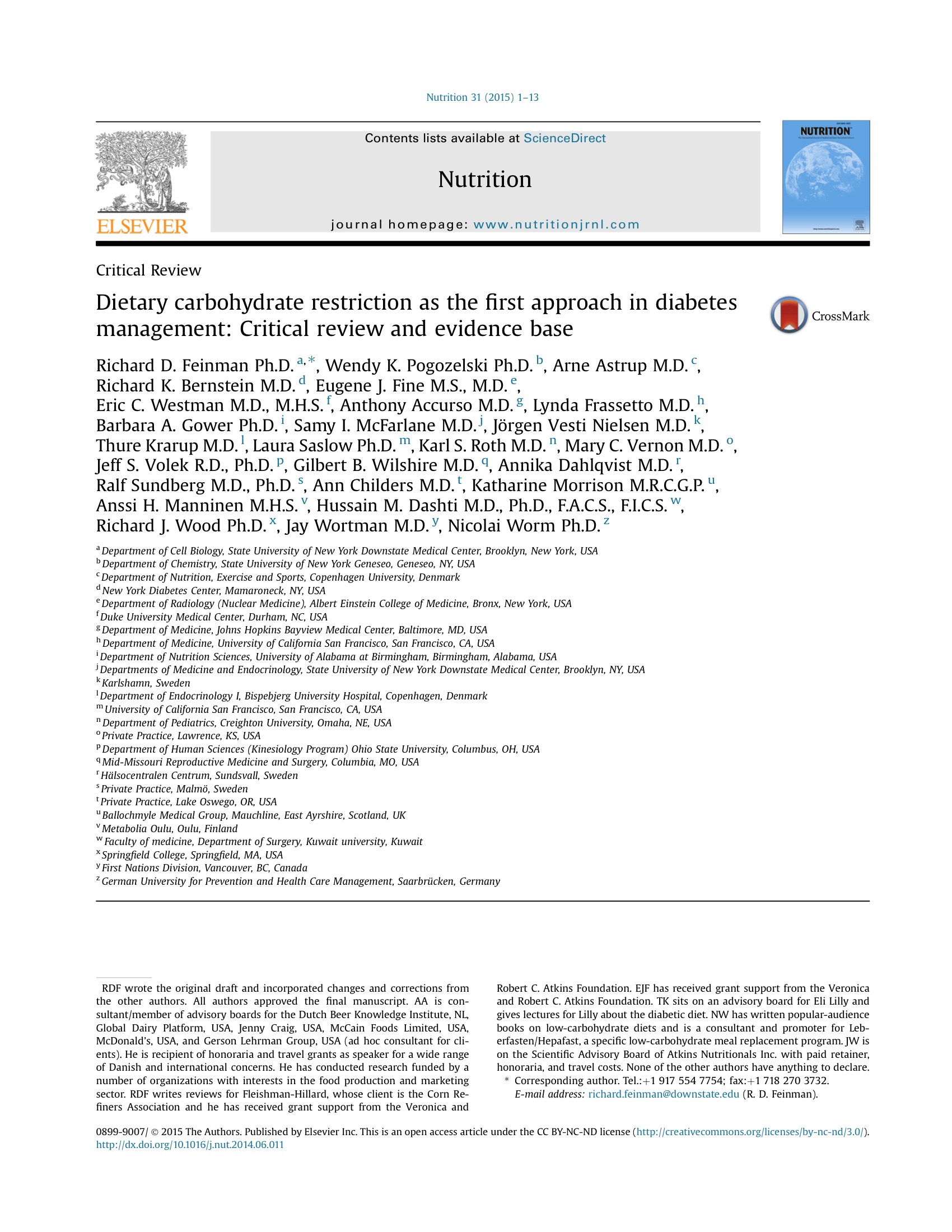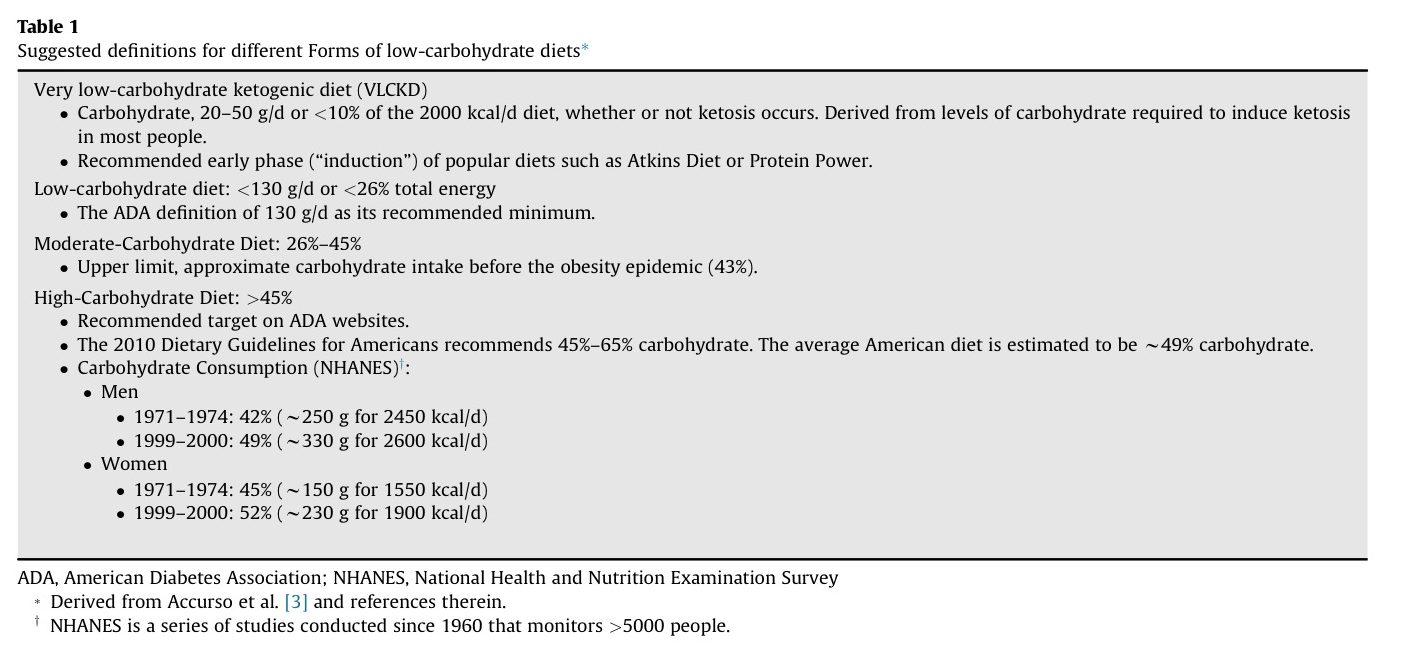
Shared under CC BY-NC-ND license (http://creativecommons.org/licenses/by-nc-nd/3.0/)
This paper, published 2 years ago (I’m still catching up), is a peer-reviewed listicle which presents 12 points of evidence challenging the conventional treatment approach of high-carbohydrate, low-fat diets for people with diabetes.
12 Points of Evidence
And…it’s all here. The 12 points are laid out logically so I don’t need to repeat them. Some of the key questions that people have are answered here:
- What’s the definition of a low carbohydrate diet?
- Is the diabetes-reversing effect of this diet based on weight loss alone? (no)
- Why does an increase in fat intake actually decrease circulating triglycerides (you aren’t what you eat, you are what your body does with what you eat) and improve lipid profiles?
- Is saturated fat bad for you? (the evidence has not shown this to be the case)
The most salient feature of both diseases (Type 1 and 2 diabetes) is hyperglycemia and the intuitive idea that reducing carbohydrate would amelio- rate this symptom is borne out by experiment with no significant exceptions…The ascendancy of the low-fat paradigm meant that the fat that would replace the carbohydrate that was removed was now perceived as a greater threat, admittedly long term, than the immediate benefit from improvement in glycemia.

Shared under CC BY-NC-ND license (http://creativecommons.org/licenses/by-nc-nd/3.0/)
A key question that’s also asked and answered is which diet is really unconventional? Is the low-fat diet or the low-carb diet. If you look at the history of diabetes management pre-insulin (carbohydrate restriction, see: Just Read: Diabetic Cookery, Rebecca Oppenheimer, 1917 (!) ) or the evidence behind changing dietary recommendations in 1977 to favor carbohydrates over fat (not there), the unconventional treatment is probably the high carbohydrate diet.

Shared under CC BY-NC-ND license (http://creativecommons.org/licenses/by-nc-nd/3.0/)
Declarations
Several (not all) of authors declare potential conflicts. In this exploration these sections are really important to read:
RDF wrote the original draft and incorporated changes and corrections from the other authors. All authors approved the final manuscript. AA is con- sultant/member of advisory boards for the Dutch Beer Knowledge Institute, NL, Global Dairy Platform, USA, Jenny Craig, USA, McCain Foods Limited, USA, McDonald’s, USA, and Gerson Lehrman Group, USA (ad hoc consultant for clients). He is recipient of honoraria and travel grants as speaker for a wide range of Danish and international concerns. He has conducted research funded by a number of organizations with interests in the food production and marketing sector. RDF writes reviews for Fleishman-Hillard, whose client is the Corn Refiners Association and he has received grant support from the Veronica and Robert C. Atkins Foundation. EJF has received grant support from the Veronica and Robert C. Atkins Foundation. TK sits on an advisory board for Eli Lilly and gives lectures for Lilly about the diabetic diet. NW has written popular-audience books on low-carbohydrate diets and is a consultant and promoter for Leberfasten/Hepafast, a specific low-carbohydrate meal replacement program. JW is on the Scientific Advisory Board of Atkins Nutritionals Inc. with paid retainer, honoraria, and travel costs. None of the other authors have anything to declare.
Interestingly, several of these should lend to a conclusion that the status-quo high-carbohydrate, low-fat diet is beneficial, some the other way around. A recent paper in JAMA addressed this issue: John P. A. Ioannidis, John F. Trepanowski. Disclosures in Nutrition Research: Why It Is Different. JAMA. Published online December 07, 2017.
Because this is so important, I’m experimenting here by posting a link to other reactions to the paper (thank you social media!)
h/t @JeffStanleyMD for the link to the paper.
Another question I’ve had for myself, is about the sustainability, from an environmental perspective, of a LCHF diet, because climate change is a threat to human health and increases health disparities among vulnerable populations. I’ll post on that next.
7 Comments
RT @tedeytan: Blog Post: Just Read: Dietary carbohydrate restriction as the first approach in diabetes management: critical review and evid…
If you think about sustainability, a lot of our current recommendations involve food waste. We’re supposed to not use the carcass fat from animals (tallow etc), cut off and throw away fat from meat, then replace some of this with oil from plants we never needed to grow before (of which one of the most common today is the environmentally egregious palm oil), and some with extra grain foods. Assuming people are going to eat the lean protein from animals anyway, and that it is safe to include the fat in the context of a low carbohydrate diet, then doing so is going to save resources. Even more resources will be saved if an appropriate proportion of protein in the low carb diet comes from organ meat, not just lean muscle as at present.
In which case current estimates of food economy, which were based on wasteful recommendations, will be falsified, and we’ll need to start again.
This recent report on global livestock conversion does not include offal or rendered fat such as tallow or lard, but does shows that most of the food fed to animals globally is unsuitable for human consumption, and much of it is the residue from human plant crops or plant food processing. Even the vegan burger – maybe especially the vegan burger – is producing waste that can only be used as animal feed.
http://www.sciencedirect.com/science/article/pii/S2211912416300013
Thank you for this, I was having difficulty understanding the GHG contribution of low vs high carb diets. If you have other references please post!
Hi Ted,
there are a few other earlier papers cited here.
https://profgrant.com/2017/06/02/defending-lchf-in-the-climate-change-debate/
The WHO and FAO research seems to have started out with extreme claims, modelled on US feedlot practice and not adjusting for carbon sequestration and other offsetting advantages, and has then reduced these estimates in each new report.
If, for example, you think that all the soy grown on deforested land in the Amazon is used to feed cattle in the US, which is the plant-based party line, this gives one set of figures. Once you find out how much of this soy is exported to China for human consumption, and how much used to make soybean oil, soy milk, etc, and that the waste left over – the seed cake, as with palm kernel expeller – is what’s fed to animals, then these estimates change.
“Currently China accounts for 57% of Brazil’s overseas soya sales and production and demand are expected to grow.”
https://www.theguardian.com/world/2017/oct/05/brazil-amazon-tapajos-hydrovia-scheme
Fantastic- thanks for these!
Hello again, I reviewed the papers and blog posts – very helpful. I was impressed at the level of ad hominem discourse in the counter to the blog post above, which to me weakens the effectiveness of the message. People like me have a desire to know rather than a desire to be right. These will inform my next few posts, much appreciated, Ted
I put some of my initial reading/thoughts in this post – thanks again for your assistance – https://www.tedeytan.com/2018/01/06/24514